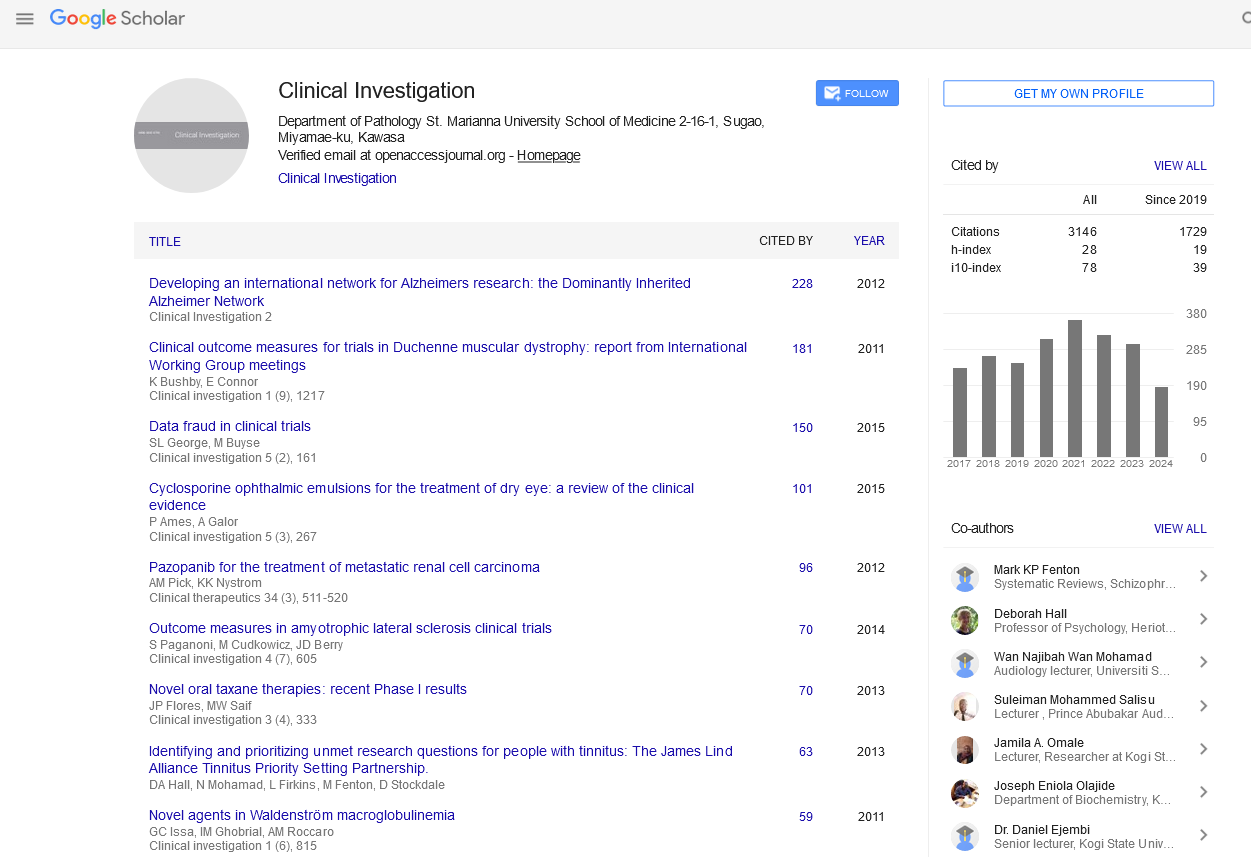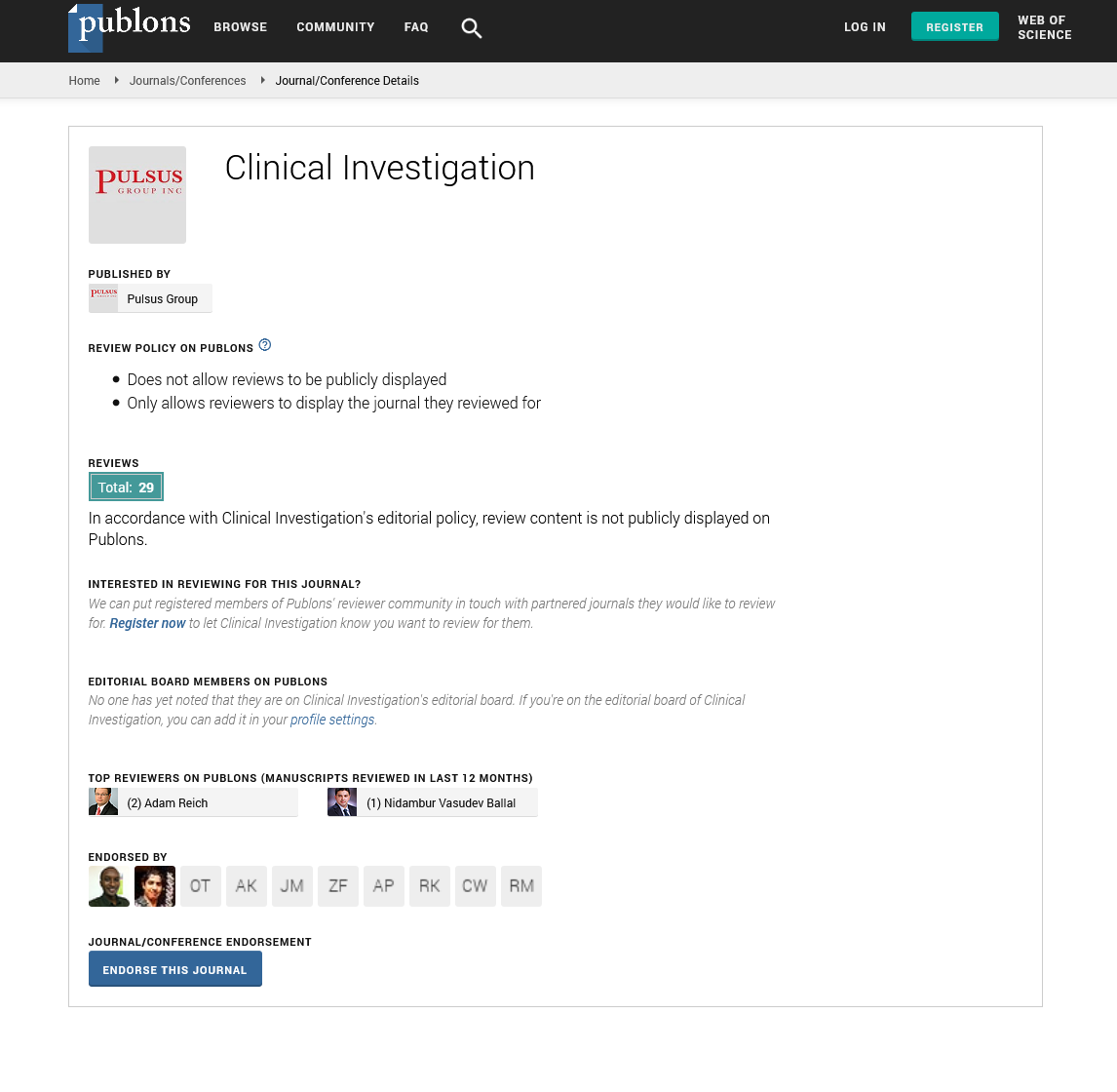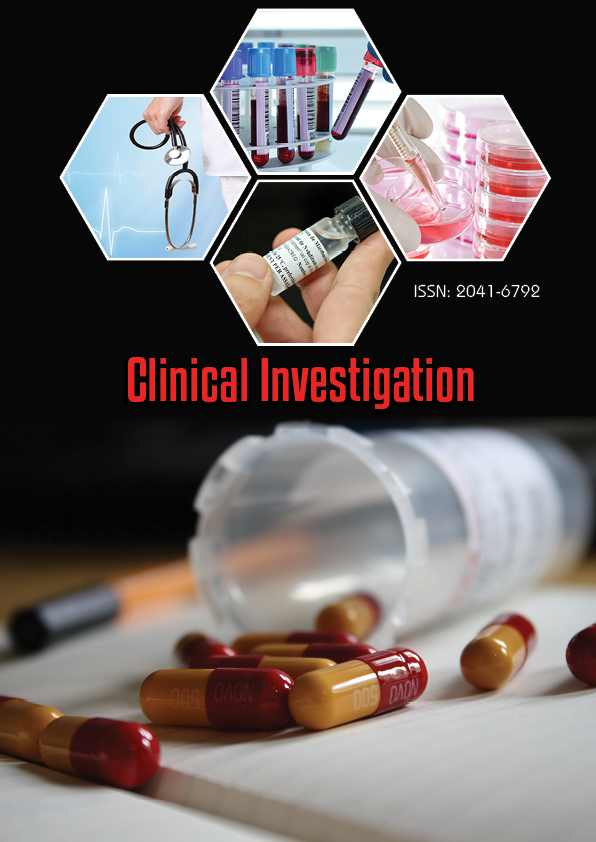Opinion Article - Clinical Investigation (2024) Volume 14, Issue 3
Clinical and Laboratory Investigation: Bridging the Gap Between Research and Patient Care
- Corresponding Author:
- Perak Yeni
Colombia University, Faculty of Biology, South America
E-mail: perakyeni@gmail.com
Received: 6-Mar-2024, Manuscript No. fmci-25-160264; Editor assigned: 8-Mar-2024, PreQC No. fmci-25-160264(PQ); Reviewed: 17-Mar-2024, QC No. fmci-25-160264(Q); Revised: 21-Mar-2024, Manuscript No. fmci-25-160264(R); Published: 29-Mar-2024
Abstract
Clinical and laboratory investigations are essential components of medical research and healthcare. These investigations are crucial for diagnosing diseases, evaluating new treatments, and advancing medical knowledge. While clinical investigations focus on understanding patient conditions through direct observation and testing, laboratory investigations involve the analysis of biological samples and data to better understand the underlying mechanisms of disease. This article explores the significance of both clinical and laboratory investigations in modern medicine, highlighting their roles in diagnosis, drug development, and personalized treatment strategies. It also addresses the challenges faced in integrating laboratory findings into clinical practice and underscores the need for continued research to enhance healthcare outcomes.
Keywords
Clinical investigation • Laboratory investigation • Disease diagnosis • Drug development • Personalized medicine • Medical research • Healthcare outcomes
Introduction
In modern healthcare, the integration of clinical and laboratory investigations is paramount to advancing medical science and improving patient care. Clinical investigations, which typically involve direct interactions with patients through medical historytaking, physical examinations, and diagnostic tests, provide crucial insights into a patient's condition. Meanwhile, laboratory investigations involve the examination of biological samples such as blood, urine, and tissue samples using a variety of tools, including microscopes, chemical assays, and molecular techniques, to analyze and understand the biological basis of diseases.
The synergy between clinical and laboratory investigations is what allows healthcare professionals to develop accurate diagnoses, create personalized treatment plans, and evaluate the effectiveness of new therapies. This collaborative approach has led to significant advancements in disease diagnosis, the development of novel treatments, and the discovery of biomarkers that aid in early detection and personalized care.
This article explores the relationship between clinical and laboratory investigations, examining their roles in disease understanding, diagnostic procedures, and therapeutic developments. It also discusses the challenges and future directions of integrating these investigative methods to enhance healthcare delivery.
Clinical investigations
Clinical investigations involve the direct observation and assessment of patients to gather information that aids in the diagnosis and management of diseases. These investigations may include the following components.
• Patient history and physical examination: One of the cornerstones of clinical investigation is obtaining a comprehensive patient history, which provides insight into the patient's symptoms, medical background, lifestyle, and potential risk factors for diseases. Coupled with a physical examination, this initial step helps form a clinical hypothesis that guides further diagnostic testing.
• Diagnostic tests: Diagnostic tests are central to clinical investigations and help confirm or rule out potential conditions. These tests may include imaging studies (e.g., X-rays, CT scans, MRIs), blood tests, and other specialized tests. Diagnostic tests provide crucial data on the structure and function of organs and systems, aiding in the identification of diseases such as cancer, cardiovascular conditions, infections, and metabolic disorders
• Monitoring disease progression and treatment response: Clinical investigations also play a key role in monitoring disease progression and assessing how well a patient is responding to treatment. Regular follow-ups, lab tests, and imaging scans help healthcare providers adjust treatment plans as needed and provide insights into the effectiveness of therapies.
• Patient-centered care: Clinical investigations emphasize a patientcentered approach, where the preferences, needs, and values of the patient are central to decision-making. Engaging patients in the investigation process leads to better understanding, improved communication, and ultimately better health outcomes.
Laboratory investigations
Laboratory investigations, which involve the analysis of biological samples, complement clinical investigations by providing detailed information about the biological processes underlying diseases. These investigations are critical for uncovering the mechanisms of disease and identifying potential targets for treatment. Key components of laboratory investigations include:
• Blood and urine tests: Blood tests are commonly used to assess organ function, detect infections, and measure levels of various biomarkers that indicate disease presence. Blood tests such as Complete Blood Counts (CBCs), liver and kidney function tests, and cholesterol levels help detect a variety of conditions, including anemia, liver disease, diabetes, and heart disease. Urine tests can similarly detect metabolic abnormalities, infections, and kidney dysfunction.
• Microbiological and genetic investigations: Microbiological investigations, such as culturing bacteria, viruses, or fungi, are vital for diagnosing infections. Laboratory techniques like PCR (polymerase chain reaction) and sequencing have revolutionized our ability to identify pathogens, even in cases of rare or emerging diseases. Additionally, genetic investigations are increasingly important for understanding the genetic basis of diseases, identifying mutations, and enabling personalized medicine. Genetic testing can uncover hereditary conditions, such as cystic fibrosis or sickle cell anemia, and guide treatment strategies based on an individual’s genetic profile.
• Molecular diagnostics: Molecular diagnostic tools allow for the analysis of DNA, RNA, and proteins to better understand disease mechanisms. These investigations can detect specific mutations, gene expression patterns, and proteins that play a role in the development and progression of diseases like cancer. For instance, liquid biopsy technologies that detect circulating tumor DNA (ctDNA) are helping to detect cancers early and monitor treatment efficacy
• Biomarkers and personalized medicine: One of the most significant contributions of laboratory investigations is the identification of biomarkers—measurable indicators of disease presence, severity, or response to treatment. Biomarkers enable personalized medicine, where treatment plans are tailored to the individual based on their unique biological makeup. For example, genetic testing for specific mutations in cancer patients can inform treatment decisions, such as the use of targeted therapies like HER2 inhibitors in breast cancer.
The integration of clinical and laboratory investigations
The collaboration between clinical and laboratory investigations is essential for developing a comprehensive understanding of patient conditions and improving healthcare outcomes. Both fields provide complementary insights: clinical investigations offer real-world data about a patient's symptoms and physical health, while laboratory investigations provide a molecular or cellular perspective of disease processes.
• From diagnosis to treatment: The integration of clinical and laboratory findings enhances diagnostic accuracy and informs the development of effective treatment strategies. For example, when a patient presents with symptoms of infection, clinical investigation through physical examination and medical history may suggest a potential diagnosis. A laboratory investigation (e.g., blood culture) can confirm the presence of a bacterial infection and determine the best course of antibiotics.
• Personalized and precision medicine: Advances in laboratory investigations, particularly in genomics, have paved the way for personalized and precision medicine. By combining genetic data obtained from laboratory tests with clinical observations, healthcare providers can design more targeted treatment regimens that are tailored to the individual patient. This integration is particularly important in oncology, where genetic profiling of tumors enables the use of targeted therapies that specifically address the molecular characteristics of a patient’s cancer.
• Collaborative research and drug development: The collaboration between clinical and laboratory investigators is also crucial in advancing medical research and drug development. Clinical trials rely on both clinical observations and laboratory findings to evaluate the safety and efficacy of new treatments. Laboratory investigations may identify potential biomarkers, while clinical trials assess how well these biomarkers correlate with treatment outcomes in real-world settings.
Challenges in clinical and laboratory investigations
While clinical and laboratory investigations have made tremendous progress in advancing medical science, several challenges remain
• Data integration: Integrating data from clinical investigations (e.g., patient history, physical exams) with laboratory data (e.g., biomarker levels, genetic analysis) can be complex. Developing effective tools for data integration and analysis is necessary for creating a more comprehensive picture of a patient's health and improving decision-making.
• Cost and accessibility: Some laboratory investigations, such as genetic testing and advanced molecular diagnostics, can be expensive and may not be readily available in all healthcare settings, particularly in low-resource areas. Ensuring equitable access to these investigations is critical to improving healthcare outcomes globally.
• Ethical and privacy concerns: Laboratory investigations, especially those involving genetic testing or the use of patient data, raise important ethical and privacy concerns. Safeguarding patient confidentiality and ensuring informed consent for laboratory testing are essential to maintaining trust in the healthcare system.
Conclusion
Clinical and laboratory investigations are indispensable tools in modern medicine, working in tandem to improve diagnosis, treatment, and patient care. While clinical investigations provide crucial insights into a patient’s health status and immediate needs, laboratory investigations offer deeper, molecular-level understanding that can lead to more personalized, effective treatments. The integration of both approaches is crucial for advancing medical knowledge and enhancing healthcare outcomes.
Despite challenges related to data integration, cost, and accessibility, continued advancements in technology and research will drive improvements in both fields. By leveraging the strengths of clinical and laboratory investigations, the healthcare system can continue to evolve, ensuring better outcomes. for patients worldwide. Ultimately, the future of medicine lies in the seamless collaboration between clinicians and laboratory researchers to provide precise, individualized care for all patients.


